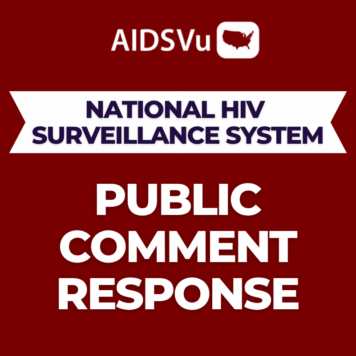December 9, 2020 – Today, AIDSVu released new interactive maps visualizing the HIV care continuum at the state-level, illustrating the extent to which people with HIV in a given state are engaged in care. These new data and maps help to inform policy and programmatic strategies to better support people with HIV and to achieve the treatment goal of viral suppression. The new data complement the city-level maps visualizing the HIV care continuum for more than 35 cities across the U.S. released on AIDSVu in June 2020.
AIDSVu also added new maps of social determinants of health indicators and related infectious diseases to help shine a light on their association with HIV and how the conditions in the places where people live can lead to disparities in achieving optimal health. These social, economic, and environmental factors play a role in HIV infection and the ability of people to access HIV testing, prevention, treatment, and care.
“These data come during a time of public health crisis as our nation and the world fight to control the COVID-19 pandemic—and as the challenges of our national healthcare system come into the spotlight,” said Patrick Sullivan, DVM, PhD, Professor of Epidemiology at Emory University’s Rollins School of Public Health and Principal Scientist for AIDSVu. “It is our hope these new interactive maps and visualizations can help the HIV community showcase the close link between disparities in HIV outcomes – especially among racial and ethnic groups – and access to basic human needs like employment, food, and housing. In many ways, social determinants of health are among the most pressing issues facing our healthcare systems.”
Social Determinants of Health:
Adding to AIDSVu’s existing social determinants of health maps on poverty, high school education, median household income, income inequality, and people without health insurance, the site now includes:
- Unemployment (2018)
- Housing (2018)
- Food insecurity (cumulative 2016 to 2018)
- Medicaid expansion (as of September 2020)
- Hepatitis C prevalence (cumulative 2013 to 2016)
- Primary and secondary syphilis prevalence (2018)
AIDSVu also added a new Deeper Look: Health Disparities and HIV page to provide users with a further understanding of the drivers of inequities in HIV risk, infections, and outcomes, as well as insights and infographics from these data.
HIV Care Continuum:
The HIV care continuum is a public health model that outlines the stages of care that people living with HIV go through from diagnosis to achieving and maintaining viral suppression – a very low or undetectable amount of HIV in the body. Once an individual is virally suppressed to the point where HIV cannot be detected in their blood, they effectively cannot transmit HIV. This is the foundational concept of Undetectable = Untransmittable, or U = U.
The HIV care continuum is vital in assessing individual care outcomes and population-level impact and helps determine if people living with HIV in a given community are engaged in each successive step. This helps policymakers and service providers better determine where resources and strategies are needed to support people living with HIV to achieve the goal of viral suppression.
AIDSVu maps the following steps of the HIV care continuum at the state-level for more than 40 states and Washington, DC:
- New HIV Diagnoses – Individuals who received a new HIV diagnosis in 2018.
- Late HIV Diagnoses – Individuals diagnosed with stage 3 HIV (AIDS) within 3 months of an initial HIV diagnoses in 2018.
- Linkage to HIV Care – Individuals who visited an HIV health care provider within 1 month of being diagnosed with HIV in 2018.
- Receipt of HIV Care – Individuals living with diagnosed HIV who received medical care for HIV in 2018.
- Viral HIV Suppression – Individuals living with diagnosed HIV who had a low or undetectable viral load (the amount of HIV in the blood) in 2018.
The HIV care continuum maps can be viewed across different demographic groups such as age, sex, and race/ethnicity, as well as alongside social determinants of health and overlaid with HIV testing, PrEP, and care service locations. For full indicator definitions, please see the Data Methods.
HIV Care Continuum & Social Determinants of Health Data Updates in 2020 include:
- ZIP Code-level maps showing late HIV diagnoses (cumulative 2014 to 2018), linkage to HIV care (cumulative 2014 to 2018), receipt of HIV care (2018), and viral HIV suppression (2018) for more than 35 U.S. cities.
- State-level maps showing late HIV diagnoses (2018), linkage to HIV care (2018), receipt of HIV care (2018), and viral HIV suppression (2018).
- Expanded stratifications for county-level maps of new HIV diagnoses (from 2008 to 2018), including by age, sex, race/ethnicity, and transmission category.
- Comparison maps of social determinants of health and HIV-related infectious diseases – such as unemployment (2018), housing (2018), food insecurity (cumulative 2016 to 2018), Medicaid expansion (as of September 2020), poverty (2018), high school education (2018), median household income (2018), income inequality (2018), and people without health insurance (2018), as well as Hepatitis C prevalence (cumulative 2013 to 2016) and primary and secondary syphilis prevalence (2018).
- Enhanced national, regional, state, county, and city data profiles, including HIV care continuum and health disparities data.
- Locations for HIV prevention, testing, and Ryan White care services, as well as locations of housing opportunities for persons with AIDS and NIH-funded HIV prevention, vaccine, and treatment trial locations, all viewable on AIDSVu’s interactive maps.
About AIDSVu & The HIV Care Continuum Data
AIDSVu is presented by Emory University’s Rollins School of Public Health in partnership with Gilead Sciences, Inc. and the Center for AIDS Research at Emory University (CFAR). Now in its tenth year, AIDSVu continues to advance its mission to make HIV data widely available, easily accessible, and locally relevant to inform public health decision making. The site aims to provide researchers, policymakers, and community members with a more comprehensive understanding of the HIV epidemic at the local-, state-, and national- level.
The HIV care continuum data and maps began as a proof of concept with the inaugural Powered By AIDSVu project HIVContinuum.org in February 2015, and now AIDSVu is expanding on this model and adding the data to the AIDSVu site. To learn more about AIDSVu’s HIV care continuum data and sources, see our FAQ and Data Methods.









